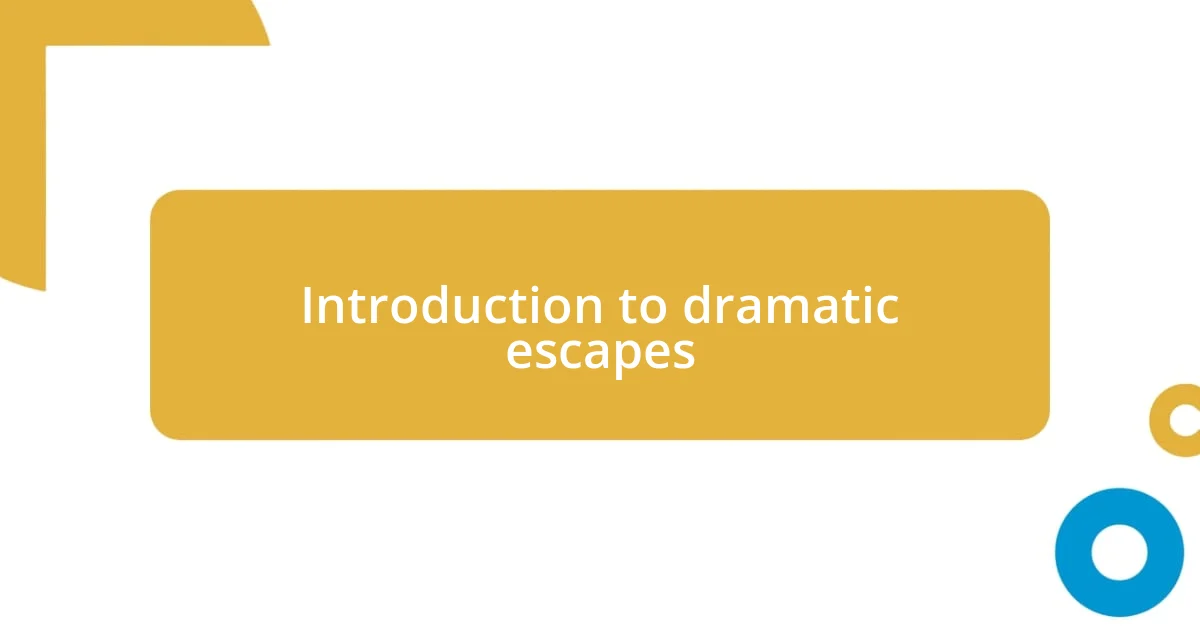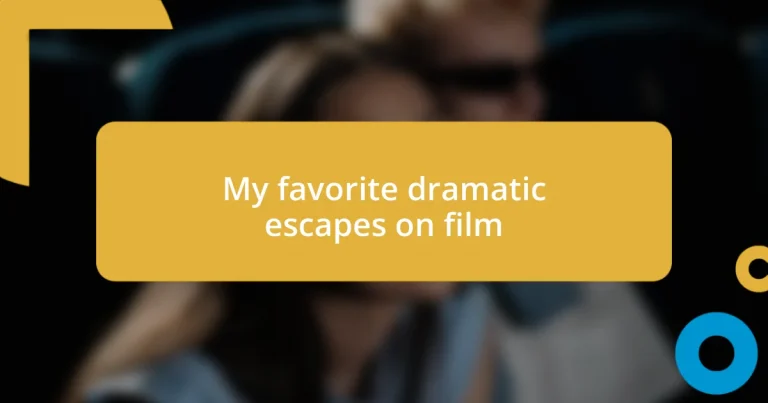Key takeaways:
- Dramatic escapes in film symbolize deeper themes of freedom, resilience, and the human spirit, evoking strong emotional responses from audiences.
- Character motivations for escapes often stem from desires for autonomy, survival, and justice, reflecting universal human experiences and struggles.
- Cinematic techniques such as close-ups, sound design, and editing significantly enhance the tension and emotional impact of escape scenes, making them memorable and relatable.

Introduction to dramatic escapes
Dramatic escapes have a unique power to captivate audiences, pulling them into the heart of tension and hope. I remember watching a nail-biting scene where the protagonist makes a daring leap from a rooftop; the adrenaline rush was palpable, and I found myself holding my breath. Isn’t it fascinating how a simple moment on screen can evoke such strong emotions?
These cinematic moments often symbolize freedom, bravery, or the desire to overcome insurmountable odds. For me, each escape is not just about the action; it represents a turning point for the characters involved. Have you ever thought about what motivates these characters to risk it all? The thrill isn’t just in the escape itself but in what it signifies—their fight for survival, their quest for a fresh start.
I’ve often found myself cheering for characters as they hatch elaborate plans to flee danger, feeling my heart race alongside them. These moments remind us of our innate desire for liberation, whether from physical constraints or emotional burdens. Don’t we all crave our own dramatic escapes at times, yearning for a break from reality?

Top films featuring escapes
The thrill of escape is woven into some of the most memorable films. “The Shawshank Redemption,” for instance, showcases Andy Dufresne’s meticulous planning and determination. Watching his journey unfold gave me chills, especially when he finally breaks free; it’s an emotional high that leaves you cheering for his triumph against all odds.
In another fascinating example, “Escape from Alcatraz” pulls viewers into the gritty reality of prison life. Frank Morris exemplifies ingenuity and courage as he plots his escape from the infamous island. It reminded me of how, sometimes, the most powerful stories can emerge from the darkest places. Don’t you find it incredible how film can encapsulate such raw human spirit?
Lastly, “Mad Max: Fury Road” presents a thrilling chase that embodies freedom on a grand scale. The high-octane action left me breathless, as the characters fight not just for survival but for a better world. It’s this juxtaposition of chaos and hope that resonates deeply with me—highlighting how the pursuit of escape can be both fierce and poetic at the same time.
| Film | Escape Method |
|---|---|
| The Shawshank Redemption | Meticulous planning and patience |
| Escape from Alcatraz | Ingenuity and teamwork |
| Mad Max: Fury Road | High-speed chase and combat |

Most memorable escape scenes
I’ve always found that escape scenes often linger in my mind, long after the credits roll. They’re charged with tension and emotion, delivering a mix of anxiety and exhilaration. One that stands out vividly for me is from “The Great Escape.” I can almost feel the weight of the mud and the push to freedom as Steve McQueen revs his motorcycle, racing toward the border. It’s more than just a getaway; it’s a testament to the indomitable human spirit and the yearning to break free.
Consider the following memorable escape scenes that really encapsulate this thrilling genre:
-
“The Great Escape” – A motorcycle chase over the German countryside, symbolizing freedom and resilience.
-
“Prison Break” – The intense moments of Michael Scofield’s careful planning, showcasing strategy and sacrifice.
-
“The Dark Knight Rises” – Batman’s audacious climb from the prison pit perfectly illustrates the struggle for redemption.
-
“Inception” – The dream layers act as barriers, making Dom Cobb’s escape both a mental and physical challenge.
Each of these scenes resonates with the idea that every escape carries the weight of hopes and dreams. Isn’t it fascinating how they serve as profound reflections of our desires for liberation?

Character motivations behind escapes
Character motivations for escapes can often be traced back to deeply rooted desires for freedom and autonomy. I vividly recall the moment in “The Shawshank Redemption” when Andy Dufresne first envisions his escape. It struck me how this dream wasn’t just about leaving prison; it was a quest to reclaim his identity and assert his humanity. Isn’t that something we all crave in our own lives, the ability to break free from our constraints?
Another compelling motivation is survival. Take Frank Morris in “Escape from Alcatraz.” His escape was not just a daring adventure; it was a life-or-death decision that required relentless courage and cleverness. Reflecting on this made me think about how, in our daily struggles, we often face our own Alcatraz-like situations where failure isn’t an option. How far would you go to save yourself?
Lastly, the quest for justice often drives characters to dare the impossible. In “Mad Max: Fury Road,” the protagonists are not merely escaping danger; they’re fighting against oppression and working toward a greater cause. I remember feeling exhilarated as they raced toward freedom, fueled by hope. It’s a reminder that sometimes, our escapes are also acts of rebellion—a way to challenge an unjust world. How powerful is that notion, that an escape can embody our fight for something better?

Cinematic techniques for escapes
Cinematic techniques play a pivotal role in crafting escape scenes that resonate with audiences. One technique I particularly appreciate is the use of close-ups. They intensify the emotional stakes, drawing viewers into the characters’ fear and determination. For instance, when a character’s sweat beads trickle down their face, I can almost feel their pulse racing. It’s simple yet effective—those small details make the moment wince-worthy and real.
Another technique that often stands out is the use of sound design. The cacophony of hurried footsteps, the pounding heartbeat, or the distant sirens amplifies the tension. During the climactic chase scenes in “Mad Max: Fury Road,” the relentless engine roars build an atmosphere of adrenaline that keeps me glued to the screen. Have you ever noticed how these auditory elements seem to sync with our own rising anxiety? It’s a brilliant way to pull us into the action.
Lastly, the editing style can significantly impact the pacing of an escape scene. Quick cuts can create a sense of chaos, while long takes might draw out the suspense. I remember being on the edge of my seat during the slow-motion moments in “Inception,” where time seemed to freeze as characters navigated perilous situations. Each choice in editing influences how I perceive the stakes, making each escape attempt memorable and thrilling. How vital do you think pacing is in evoking emotional responses during such scenes? For me, it’s everything.

Cultural impact of escape films
Escape films have wielded significant cultural influence, shaping not only cinema but also societal attitudes toward freedom and individualism. I recall watching “The Great Escape” as a child, feeling a profound sense of camaraderie with the characters. Their determination sparked conversations among my friends and family about what true freedom means—not just for the characters but for us in our everyday lives. How often do we celebrate those who dare to break free from the norm?
Moreover, these films often mirror societal struggles and highlight various injustices. For instance, “12 Years a Slave” didn’t just tell a harrowing tale of survival but also ignited discussions about race, history, and human rights. It reminded me that cinema can be a powerful vehicle for change, prompting audiences to confront uncomfortable truths. When characters escape, they’re often challenging broader systems of oppression. Isn’t it intriguing how these narratives can encourage us to reflect on our own challenges and victories?
The popularity of escape films also speaks to a collective yearning for liberation amid societal constraints. When audiences laugh, cry, or cheer during these cinematic journeys, they’re engaging with a universal desire for autonomy. After seeing “Prison Break,” I found myself daydreaming about my own constraints and how I might overcome them. It poses an interesting question: what escapes do we seek in our lives? I believe this connection between cinema and personal experience is what makes escape films not just entertaining but deeply impactful.

Lessons from film escapes
One of the key lessons I’ve drawn from film escapes is the power of resilience. Characters often face insurmountable odds, yet their unwavering determination to break free inspires me. I remember watching “The Shawshank Redemption” and feeling a surge of hope when Andy Dufresne finally escapes. It made me reflect on my own challenges—how often do I persist despite the odds? Practically, this reminds me that every setback can be a setup for a greater comeback.
Another insight I glean from these escapes is the importance of strategy. Many filmmakers show that a successful escape often relies on careful planning and resourcefulness. Take “The Great Escape,” for instance; each character contributes their unique skills to the overall plan. This collaborative effort got me thinking: in our daily lives, how often do we overlook the value of teamwork? I find that pooling resources and ideas can lead to creative solutions that one person alone might miss.
Lastly, these narrative journeys remind me of the freedom we all crave, whether it’s physical, emotional, or mental. Watching characters break through barriers makes me question my personal ‘prisons.’ What walls am I building around myself? I had an enlightening moment during “The Pursuit of Happyness” when Chris Gardner’s grit struck a chord. It led me to realize that sometimes, the biggest barriers we face are the ones we create in our minds. Embracing vulnerability and seeking support from others can be the most liberating escape of all.













